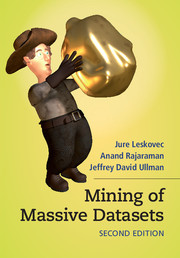Book contents
- Frontmatter
- Contents
- Preface
- 1 Data Mining
- 2 MapReduce and the New Software Stack
- 3 Finding Similar Items
- 4 Mining Data Streams
- 5 Link Analysis
- 6 Frequent Itemsets
- 7 Clustering
- 8 Advertising on the Web
- 9 Recommendation Systems
- 10 Mining Social-Network Graphs
- 11 Dimensionality Reduction
- 12 Large-Scale Machine Learning
- Index
- References
6 - Frequent Itemsets
Published online by Cambridge University Press: 05 December 2014
- Frontmatter
- Contents
- Preface
- 1 Data Mining
- 2 MapReduce and the New Software Stack
- 3 Finding Similar Items
- 4 Mining Data Streams
- 5 Link Analysis
- 6 Frequent Itemsets
- 7 Clustering
- 8 Advertising on the Web
- 9 Recommendation Systems
- 10 Mining Social-Network Graphs
- 11 Dimensionality Reduction
- 12 Large-Scale Machine Learning
- Index
- References
Summary
We turn in this chapter to one of the major families of techniques for characterizing data: the discovery of frequent itemsets. This problem is often viewed as the discovery of “association rules,” although the latter is a more complex characterization of data, whose discovery depends fundamentally on the discovery of frequent itemsets.
To begin, we introduce the “market-basket” model of data, which is essentially a many-many relationship between two kinds of elements, called “items” and “baskets,” but with some assumptions about the shape of the data. The frequent-itemsets problem is that of finding sets of items that appear in (are related to) many of the same baskets.
The problem of finding frequent itemsets differs from the similarity search discussed in Chapter 3. Here we are interested in the absolute number of baskets that contain a particular set of items. In Chapter 3 we wanted items that have a large fraction of their baskets in common, even if the absolute number of baskets is small.
The difference leads to a new class of algorithms for finding frequent itemsets. We begin with the A-Priori Algorithm, which works by eliminating most large sets as candidates by looking first at smaller sets and recognizing that a large set cannot be frequent unless all its subsets are. We then consider various improvements to the basic A-Priori idea, concentrating on very large data sets that stress the available main memory.
Next, we consider approximate algorithms that work faster but are not guaranteed to find all frequent itemsets. Also in this class of algorithms are those that exploit parallelism, including the parallelism we can obtain through a MapReduce formulation. Finally, we discuss briefly how to find frequent itemsets in a data stream.
The Market-Basket Model
The market-basket model of data is used to describe a common form of many-many relationship between two kinds of objects.
- Type
- Chapter
- Information
- Mining of Massive Datasets , pp. 191 - 227Publisher: Cambridge University PressPrint publication year: 2014



